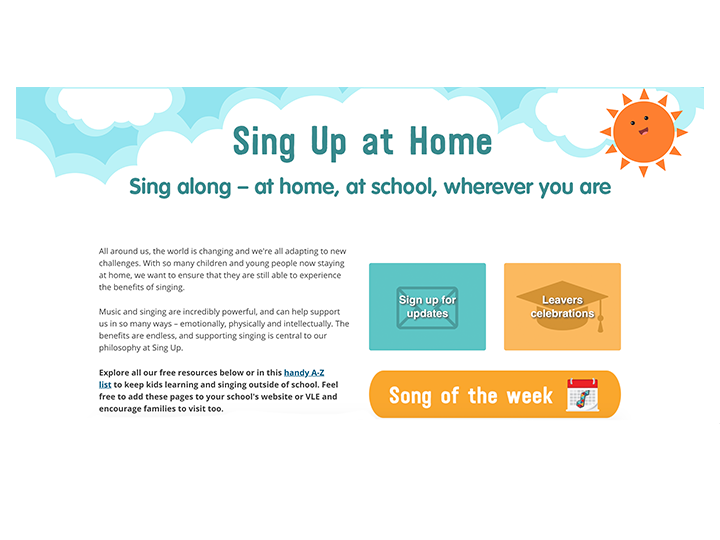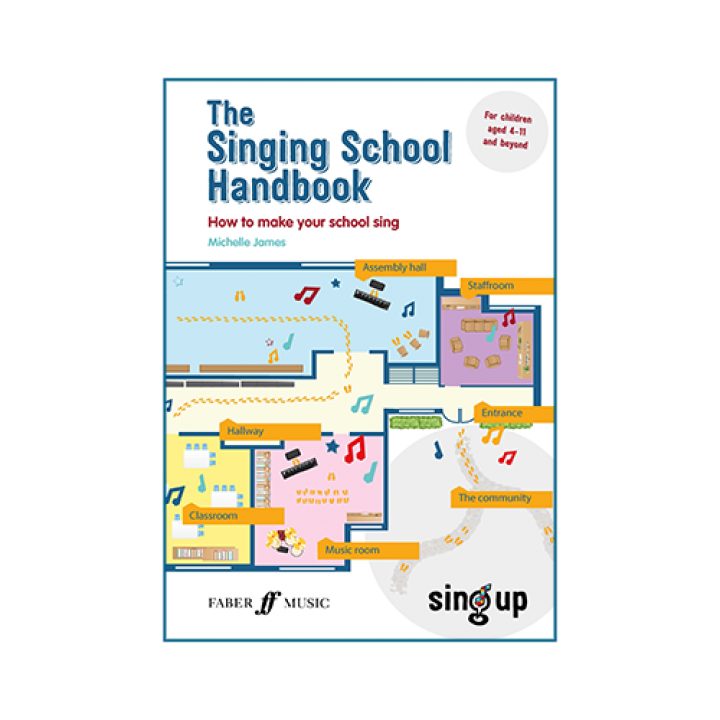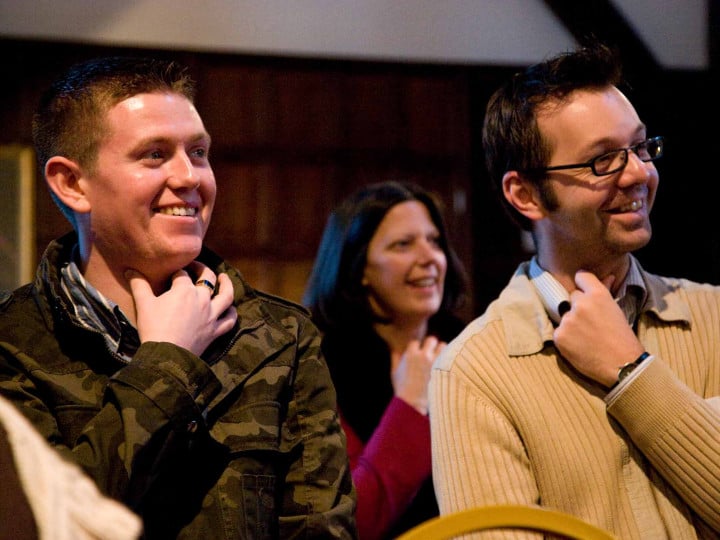
The voice is our first musical instrument, it is the instrument that everyone has, and from our earliest moments of life we are learning to use it, experimenting with the sounds it can make and using it to communicate with others.
It is a part of our bodies and so is made of the same stuff that the rest of our anatomy is made of – muscle, cartilage, tissue – and is as susceptible as other parts of our bodies to illness, stress, strain and injury. So, we need to know how to take care of it. For teachers in particular, it is a vital tool of your trade. Teachers spend a huge amount of time communicating through speaking, often when tired, stressed and sometimes straining to be heard over general classroom noise. Teachers are very prone to developing vocal problems and it’s especially inconvenient to lose your voice if you’re a teacher.
Children’s voices are still developing as their physical vocal apparatus grows and they gradually become more and more in control of it. When they are little their physical vocal apparatus is smaller and different to an adult’s, so there are things an adult’s voice can do which a young child can’t. If we are responsible for leading singing with children, we need to be aware of these differences and make sure that we are not encouraging them to strain their voices, and also, that we are teaching them good vocal health and technique for later life. Bad habits learnt early on are difficult to un-learn.
There isn’t room here to provide a comprehensive guide to vocal health and technique but here are some basics and a general overview. A fuller explanation is available on Sing Up’s website called ‘Inside the Voice’ written by vocal experts Jenevora Williams and Stuart Barr.
Look after your own voice first
Research shows that teachers are far more likely to suffer voice problems than people in other professions. National Health Service data shows that teachers are nine times as likely to be a voice clinic patient than the average adult. And teachers of primary-aged pupils (4-11 year olds) are the most likely of all to suffer with voice problems. This might be connected with average class-size, or general noise levels in a primary class, or that more of a primary teacher’s time is spent speaking than with older age-groups.
Five main factors can negatively affect our vocal health:
- Using the voice too much
- Using the voice too loudly
- Poor vocal technique
- Illness
- Emotional stress
- Irritants
Here are some things to be aware of and what you can do to look after your voice.
Using the voice too much
Instead of speaking for long periods of time without a break, which will cause voice strain, try to build in frequent breaks.
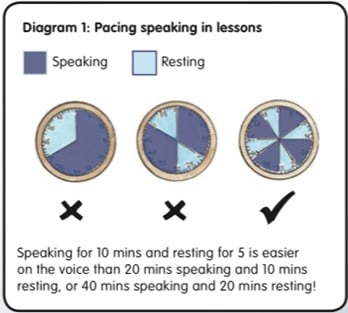
Using the voice too loudly
Whether speaking or singing, try to keep within the natural range of your voice and not strain to be too loud. Teachers can fall into the habit of using a higher-impact voice quality than is necessary. Prolonged use of this tone of voice will make your voice tired.
Instead of straining your voice in class, experiment with ways of gaining your pupils’ attention – by clapping your hands for example – to give a signal that it is time for them to be quiet. You might try a silent signal that they can learn means to stop talking and pay attention to you – holding your right hand up in the air for example. Try to make a rule for yourself that you won’t speak until the classroom is quiet enough for you to be heard while speaking in a normal, unstrained voice.
Poor vocal technique
We’ll talk about vocal technique for your pupils later in this chapter. For yourself, try following these simple rules:
- Don’t hunch, twist or bend while using your voice. It puts the voice and your breathing apparatus under strain
- Stand or sit up straight, with a straight back, relaxed neck and shoulders
- Warm-up your voice before you use it. Like any part of the body, your voice needs warming-up to avoid strain. We’ll look more at how to use warm-ups later on. They don’t need to take long and you can do them in the shower or in the car on your way to work
- Get to know when your voice is starting to feel tired and rest it before you suffer more serious problems.
Illness
Illnesses which affect the respiratory system – like coughs and colds – are likely to affect your voice. Try to get plenty of rest (rest your voice and get enough sleep), drink plenty of water. Old-fashioned remedies like inhaling steam with a towel over your head actually do work! It helps to rehydrate the throat and soothe irritation.
Not getting ill in the first place is the best solution – so having a healthy diet and avoiding viruses by washing hands frequently will help reduce the chance of infection.
Other health-related suggestions if you’re having problems with your voice are:
- Keep a bottle of water with you and take frequent sips throughout the day
- Avoid caffeinated drinks and alcohol – or at least balance with plenty of water
- Avoid sweetened fizzy drinks, milky drinks, chocolate, yoghurt and other dairy products because they can encourage mucus production
- Try to avoid eating just before going to bed. It can cause acid reflux which can irritate the throat and voice.
- Don’t smoke – obviously.
Emotional stress
Your voice is particularly vulnerable to stress. In extreme cases, prolonged periods of emotional stress have been known to cause people to lose their voice entirely or to lose part of their vocal register. Tension manifests itself in the physical apparatus we use to speak and sing very readily. It can cause the throat, chest and shoulders to tense-up and this can put the voice under significant strain. Have you noticed how hard it is to try to sing when you are crying, or how your voice wobbles when you are upset or angry?
Breathing exercises are a good way to reduce stress. You are more likely to get ill or use your voice less effectively if you are stressed or worried.
Irritants
You might be sensitive or allergic to dust, pollen, art-materials like some paints or spray adhesive. Some food sensitivities can affect the throat too. See if you can identify what you are sensitive to through a process of elimination. If the problem is more than a minor irritation, see your Doctor.
Warm-up theory
Warming up the voice before use can prevent injury, improve technique, help with motion, eliminate tension and make our brains more alert.
A good vocal warm-up should:
- attend to warming up vocal muscles and the brain
- release tension
- work on ease and range of motion in the muscles
- do gentle work before big work.
A singing warm-up routine should involve:
- waking up and balancing the body
- breathing
- releasing the throat
- warming up the voice
- exploring resonance
- clarifying articulation
Common misconceptions of warm-ups
- Warming up involves lots of jumping up and down.
These might be fun and get your pupils energised but since you don’t use your legs much for singing it won’t be of direct benefit. - Warming up heats up the muscles.
Not really. It is more about getting them moving and working – doing small work before big work so as not to take your muscles by surprise and strain them. - Warming up is a luxury I don’t have time for!
It really needn’t take long – 5 minutes or less – and it will mean you get more out of the singing when you get to it.
Warming up your speaking voice
It’s a really good idea to warm-up your voice before everyday use if you are a teacher and it only needs to take two or three minutes. Here’s what you can do:
- Body stretch: stretch your arms up then gently flop forwards from the waist, letting your arms dangle. Have a little shake to release tension. Slowly roll yourself back to an upright position until your back is straight and you imagine your head is being pulled gently upwards by a piece of string. This will align your back and neck nicely.
- Released breathing: do some slow hisses with your hand on your stomach. Feel your belly pull in. Then release your belly muscles as you breathe in again.
- Range: on a humming sound or an ‘ng’ sound, slide up and down like a siren. Gradually go a little higher and a little lower to reach the more extreme ends of your voice range.
- Efficient voicing: siren up and down to some buzzes (‘vvv’ and ‘zzz’) making sure they sound buzzy not breathy. Think of using very little air in your sound. Then siren up and down to open vowel sounds.
Warm-ups and the basics of good vocal technique
Understanding the basics of good vocal technique and helping your pupils to adopt them is part of the responsibility of being a singing leader. Good technique will produce a better sound and will help protect the voice against wear and tear. It will also stand pupils in good stead for later in life if they want to continue with singing if they have a good basic technique from an early age. Advanced technique shouldn’t be attempted until the student is much more mature because the voice continues to change (for both boys and girls) through puberty and adolescence and some basic technique will see them through for much of that period. A healthy, natural technique producing a natural, unforced sound is what you’re aiming for with young singers.
With a good vocal technique, what you’re trying to achieve is efficiency of voicing – most sound for minimal effort and fine muscle control – using only the muscles that are needed.
There are three parts to voice production to consider:
Power – the respiratory system
Source – the larynx
Filter – the upper vocal tract
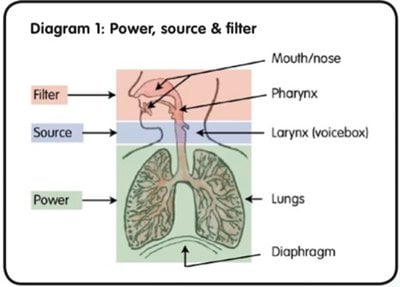
Idea:
When you’re warming-up with your pupils, make the connection for them between warming-up to sing and warming-up before physical exercise. You could show them video footage of Olympic athletes or a football team doing their warm-ups before a match. Explain to them that because they are using their bodies when they sing, they need to warm them up first, then they will work better.
Try these Singing warm-ups:
Warm-up 1: Wake up and balance the body
- Make sure your class is calm, focussed and that you have their attention.
- Gently work torso muscles by jogging on the spot, circling your arms, or dancing
- Stretch the torso muscles with some forward bending and side stretches. Keep breathing normally while stretching
- Release tension in the neck, shoulders and jaw with yawning, gentle neck stretches, shoulder circling (forwards and backwards) and shoulder scrunches. Do circles with the head – down to the chest, round to the shoulder and back again (not tilting the head backwards)
- Stand straight, but in a natural position with the weight evenly balanced between toes and heels and from side to side, without stiff knees. It is much easier to breathe when your posture is straight.
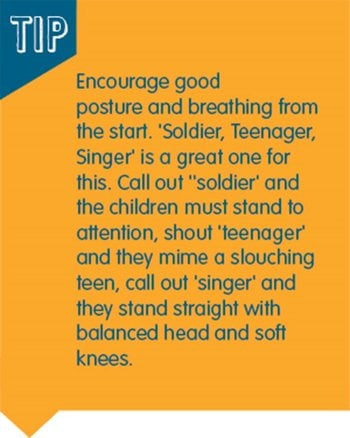
Good posture and good breathing are interlinked. Standing up straight with the ear, shoulder, hip, knee and foot in alignment is what we are aiming for. For longer singing sessions where some periods of being seated are necessary, sitting on the front of a chair with a straight back is OK. Sitting on the floor is no good at all and should be avoided if possible. Primary school children do spend quite a lot of time sitting on the floor, but it isn’t the best position for good and healthy singing because all their respiratory equipment will be scrunched up. If you think about the warm-up exercises described in this chapter – the stretching and releasing of tension – you will see that it is impossible to replicate those body positions while sitting on the floor.
Warm-up 2: Breathing
The aim here is to be making use of the lower abdomen – belly – for breathing rather than shoulders and upper chest, but without undue effort. It should feel natural and unforced.
- Get your singers to put their hands on their bellies to feel the movement in as they sing, and out and out as they breathe in
- Use ‘shhh’, ‘fff’ or ‘sss’ sounds to feel this movement initially and then voiced sounds ‘vvv’ and ‘zzz’. You can also try a rolled ‘rrr’ and ‘brrr’
- Now try this to rhythmic patterns of hisses or shushes and feel the flexibility of the muscles.
Warm-up 3: Release the throat
When we sing, we want to avoid the throat being constricted because this causes tension and affects the sound we produce. We are aiming to sing with an ‘open throat’. Try these exercises to get the feel of it:
- Breathe in as silently as possible and as if you have just had a happy surprise – imagine you’ve won the lottery or been given the best present ever
- Imagine a silent giggle in your throat. Practice returning to a natural throat position and then the silent giggle position
- Try imitating monkey noises – ooh ooh ooh aah aah aah – with a feeling of looseness in the throat
- Sing through closed but vibrating lips, with puffy cheeks. The muscles of the face and lips should be soft, and the sound should be gentle.
Warm-up 4: The voice
This is actually an exercise to warm up what are known as the ‘vocal folds’. For a fuller explanation, refer to ‘Inside the Voice’ on Sing Up’s website where a thorough and detailed description of the vocal apparatus is given by experts Jenevora Williams and Stuart Barr.
The aim is to exercise the voice throughout the pitch range and to practise clear tone and ‘onsets’ – how you start a sung note - and also iron-out register breaks – where the voice shifts from one place to another and there can be an audible ‘gap’.
- Slide up and down small distances (across no more than the distance of 5 notes apart) to ‘ng’. Gradually expand the range of the slide to higher and lower pitches
- Think of using as little air as possible in the sound, while keeping the sound clear and mobile
- Extend the pitch range to include both extremes of the voice
- Open from ‘ng’ onto quiet vowel sounds: ‘ee’ – ‘eh’ – ‘ah’ – ‘oh’ – ‘oo’
- Do the same sliding exercises using ‘vvv’ and ‘zzz’. Then try sliding on a rolled ‘rrr’ and ‘brrr’
- Try singing ‘heeh’ with a breathy ‘h’ at the start. This should give a very gentle start to the note. Then practice singing ‘uh-oh’ which will have a bumpy start to the note. Finally sing ‘eee’ with no breathiness or bump at the beginning of the note, just a nice clean start.
One goal of singing training is to iron out gaps between registers. Registers are often referred to as ‘chest’ and ‘head’ voices, terminology which reveals the historic (but inaccurate) idea of different places of resonance for different registers. Research has revealed that the registers are actually created by differing vocal fold vibration patterns rather than places of resonance.
Singers who have not yet learned to blend registers experience a noticeable change from the thicker, ‘chest’ voice to the thinner, ‘head’ voice. Audible change is less noticeable in children and men due to anatomical differences. The ‘head’ voice is often the weaker register, but can be improved with work on resonance, breathiness and through general familiarity.
Blurring the distinction between registers can be achieved by sliding up and down to ‘ng’ (as in ‘sing’). This helps the singer work out their mechanism for getting from one register to the other. Once this has been mastered, use open vowel sounds. Then try using scales that cross the register breaks, keeping the same smoothness of sound found on the slide.
Warm-up 5: Explore resonance
Practising how well your voice resonates helps build voice projection and means you don’t have to try so hard to sing loudly – which can put strain on the voice.
- Have fun making witch-like cackle noises and quacking – this will be a very nasal sound.
- Then try this sensation with the resonance in the mouth and not the nose.
Warm-up 6: Clarify articulation
These exercises help with the singing of text:
- Drop the jaw like a trap door. Sing ‘ya ya ya’ exercises with the tongue doing the articulation and the jaw loose but still
- Practise tongue isolation by touching the outer edge of the upper and lower lips with the tip of the tongue, without moving the jaw forward
- Put a finger between your lightly closed teeth and sing a phrase. Then drop your jaw, let your tongue hang out and do the same
- Check that the tongue does not press back as it moves towards ‘ah’. There should still be a feeling of lift in the middle. As you move from ‘ah’ through ‘oh’ to ‘oo’, the change will primarily come from bringing the lips forward, with minimal tongue movement
- Once you’ve practised these articulations, use your own tongue-twisters sung on descending scales.
Bringing it all together
How can you put these ideas into practice?
- Think about how you use your own voice in and out of school. Anything you want to change?
- Hold a vocal health staff meeting – take staff through the basics of voice care, the basics of technique and warming up, or invite in an expert
- Learn a range of warm-ups to use with children.
- Plan a series of warm-up routines for assembly, singing practice, choir, music lessons.
Extract taken from The Singing School Handbook by Michelle James. Published by Sing Up and Faber Music. Available on the Sing Up Shop here: https://shop.singup.org

